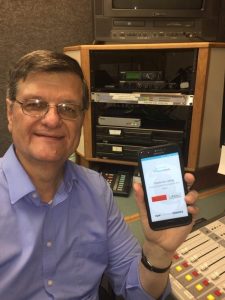Podcasters can’t always be in the same room as their guests.
While most podcasters work out of home or podcast recording studios, many guests or co-hosts are often located across the country. Calling in on the phone is convenient, but doesn’t provide a high quality listening experience. Hosts and guests need to sound as though they’re sitting right next to each other, even though they might be on different coasts.

Jim Stewart, Operations Director for New Life Radio, showing the Opal guest interface in hand. Comrex ACCESS and Opal units can be seen in the rack behind Jim.
The solution is often Skype, but Skype requires installation and configuration to work. It takes time for guests to download the application and set it up, time that they may not have. Plus, Skype audio is frequently tinny and subpar. It’s important for podcasts to maintain a consistent production value, and settling for bad audio isn’t worth it.
So how can podcasters get crisp and clean audio from their guests? How can podcasters ensure that their product sounds great, and that listeners won’t be distracted by bad audio?
Opus audio codec
Opus is an audio encoder built into most modern browsers. It provides better-than-phone quality audio, and because it exists in browsers, there’s no extra application for your guests to install.
Opal is an IP audio gateway that enables guests to connect to the studio using Opus, by simply clicking a link. It provides HD quality audio from consumer-grade equipment, like a cellphone or a computer with a microphone. It’s easy enough to use without a technical background, and most importantly, it sounds great.
Joe Emert, president of Life Radio Ministries, uses Opal to facilitate guest interviews over IP connections. “From hotel rooms and places with 4G services, the audio sounds excellent. We do a lot of interviews with authors and artists, and we hope to use Opal for those. All they have to do is click a link to get connected. Even if they use it on their smartphone, it’s going to be a much better connection than a standard telephone connection.”
Plus, Opal allows for individual branding, which is important in a crowded podcasting market. “We were very pleased to learn that when we set up our Opal, there’s a way to put our logo into Opal,” said Joe. “So when our guests click our link through their iPhone or computer, they see our logo on the Opal homepage.”
“It’s really helpful for artists and authors who are doing press tours and don’t know much about us – they can look at their screen while talking and the name of our radio station, which will make it easier for them to name drop us.”
For podcasting studios with limited budgets, Opal is accessibly priced. “Opal fits right into our tight non-profit budget. We’re excited about it – it’s going to open up a lot of doors for our programming.”
